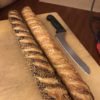Recently, Brendan went to a new restaurant in New York City that serves “kubeh,” a Kurdish treat that is essentially a ball of dough made of bulgur or rice and filled with lamb, beef or vegetables. Chef Melanie Shurka opened the restaurant, also called Kubeh, and serves these morsels, Israeli style, in beautiful broths like beet, Persian chicken, chard and more.
Now, we know what you’re thinking– these sound like Middle Eastern dumplings, right? Well, when Brendan started chatting with Melanie, she had one request:
Melanie Shurka: That we try to just call it kubeh and not call it a dumpling?
Brendan Francis Newnam: Oh, sure. Well, let’s start right there. In a lot of the media coverage of this spot, they do call it a dumpling.
Melanie Shurka: So, dumpling is the word we have for something inside something, and that’s really what it means. The problem with the word dumpling is that, most people, it makes them think of something Asian.
Every culture has something stuffed with something else, and I really hope that from this restaurant, we can have the word kubeh be part of the everyday language and start calling it “kubeh,” just the way we call it a burrito, and not, I don’t know, a wrap.
Brendan Francis Newnam: So, looking at your menu, you items informed by Kurdistan, you have items from Iraq, Syria. For someone who doesn’t know about the cuisine of that region, that vast region, is this a universal item that you would find in all these cultures and countries?
Melanie Shurka: Yes. Most people know kubeh, which is what they think of in this fried bulgur wheat, formed into like a roundish shape, with ground beef and pine nuts on the inside. And that’s the one that you find in Lebanese, Syrian, Palestinian, Israeli, you find it in all of those cuisines.
And then there’s kubeh, which is the same word, it’s just the way it’s said in the Kurdish accent, and they do it in a broth. You find, specifically, the Kurds, the Iraqis and the Syrians do a version in a broth. Palestinians do one as well, all different ones, and I’m focusing on that one, even though we do the fried one as well, just because you can almost not get it anywhere in the U.S.
Brendan Francis Newnam: Tell me about your relationship to this dish.
Melanie Shurka: I’m a New Yorker, born in New York. My father’s from Israel, my grandparents are from Iran. I grew up with Israeli and Iranian food, and actually specifically kubeh, when I was 16, I had an Israeli-Iraqi boyfriend who told me, “You have to have my mother’s kubeh. It’s the greatest thing in the world. People wait in line for it.” I thought I knew everything about Middle Eastern cuisine, but it was nothing I ever had. I finally had it, and it’s something that I remember savoring over this dish, and I remember how the beef from the kubeh shell poured out of the kubeh into this beet broth and sort of changed the consistency of the broth into something that I really loved.
Brendan Francis Newnam: So how did you arrive here?
Melanie Shurka: This is a journey of like five years. About five years ago, I decided I wanted to open up a restaurant. Previous to that, I worked as a server for years, and I loved it. I actually had gotten my law degree and became a lawyer.
Brendan Francis Newnam: I too have a law degree that I pay for on the 15th of every month, but don’t use.
Melanie Shurka: I’m happy I did it, but it very quickly realized that I’d rather talk to you about your crème brûlée and how it is and how it’s not, versus being in court. Very quickly I was like, “This is where I need to be. I love being of service to people.”
Brendan Francis Newnam: I also just like to be able to wear more casual clothes.
Melanie Shurka: I like wearing more casual clothes, too! That’s a huge bonus to this industry. I did spend three weeks in Israel learning kubeh authentically with a Syrian woman, with an Iraqi woman, with a Kurdish woman in two different restaurants. And then, spent a year developing the recipes and saying, “You know what, I like the way the kubeh dough is made by this woman, but I like the meat that was done at this restaurant.”
And I took little things here and there and developed, which is definitely authentic kubeh, but there’s definitely my twist on it, and sometimes little undertones of a little Persianness that is added to the flavors.
Brendan Francis Newnam: OK, so I’m going to just eat some of this because this is just this gorgeous, gorgeous, rich, red color.

Melanie Shurka: This is the selek broth. Selek means beet in Hebrew. It’s a beet soup that’s very traditional in Iraqi culture, and it has beef kubeh in it. However, the beef kubeh is called siska.
Traditionally, the beet broth would come with a rounded ball-like kubeh, with grounded beef on the inside. We’re serving it with the siska, which is the Kurdish kubeh. It’s like a slow-cooked meat that traditionally they do it with oil, but I do it by slow-cooking it for over three hours. And we pull the beef and then fill it into this bulgur and semolina dough. So we serve that one, you can have it in any of the broths.
Brendan Francis Newnam: I’m going to try it here in the beet broth. I’m going to bring it closer to me. I’m wearing a white shirt and eating beet broth. [Tastes it.] Wow. That is exquisite. Sometimes when I eat little morsels like this, I know what it’s like to be a wild animal, capturing something. It’s so primal and satisfying.
Melanie Shurka: That’s exactly what I want you to feel.
Brendan Francis Newnam: And there’s more, I’m assuming more broth is now blending with this beef while I’m eating it.
Melanie Shurka: Definitely, yeah. That’s sort of the experience. I always taste the soup first, then I cut into the kubeh with the spoon, and you just get a little bit more flavor. It’s changing the flavor, because there’s flavor in the beef that’s not in the soup, and now it’s changing the flavor of the soup.
Brendan Francis Newnam: And the beet has an earthiness, of course, but there’s a cleanness to the broth, I don’t know if that’s a lemon or something. So, juxtaposed with the richness of the beef, it kind of softens what you’d think would be a heavier kind of item.
Melanie Shurka: Exactly. Also, we make these broths on the lighter side for the summer. As it gets colder, we’ll maybe go a little thicker, but… I think that’s most people’s impression [is], “Oh, it’s a lot lighter than I was expecting.” It feels really soothing, even in the hot weather.
Brendan Francis Newnam: Well, thank you so much for sharing this with us! I totally think this was a better decision than appearing in a court of law in a business suit every day.
Melanie Shurka: I think so too. Thank you.


